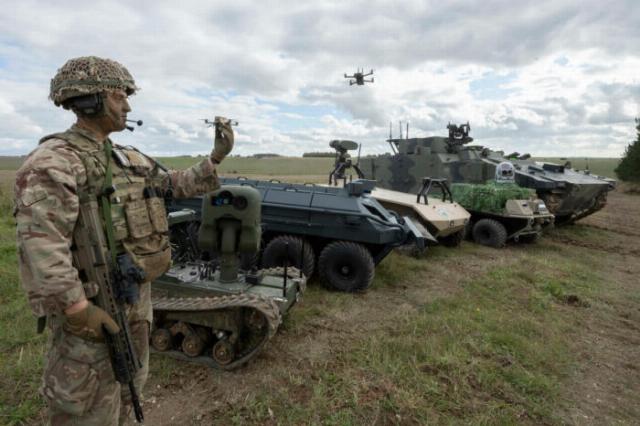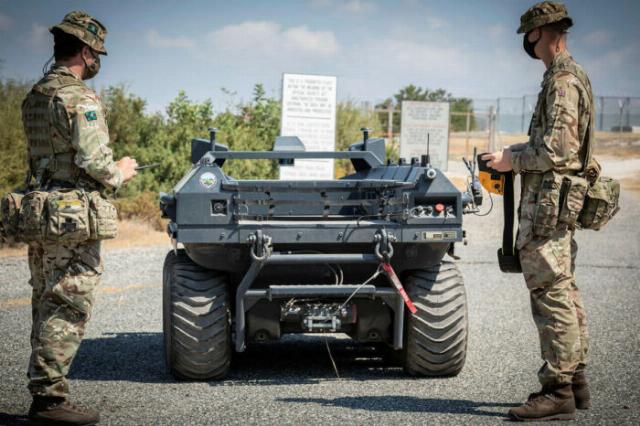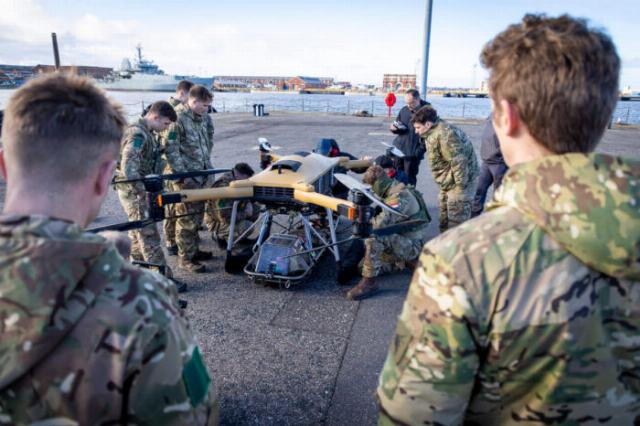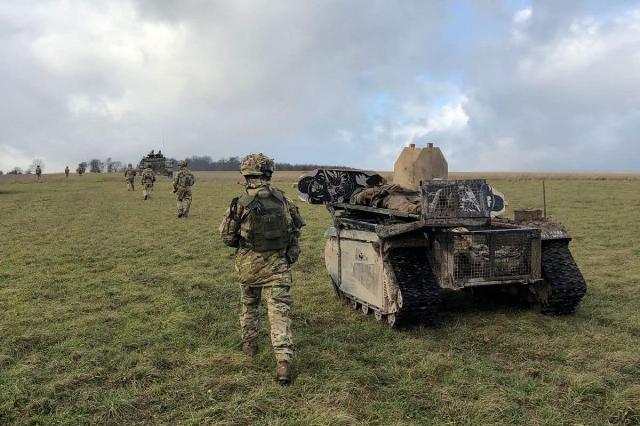Like other major armed forces, the British army is systematically striving to introduce advanced autonomous unmanned platforms into its formations.
“Soldier of the Future” and unmanned platforms
The British Army operates many unmanned systems. The main applications include explosive ordnance disposal (EOD), as well as aspects of reconnaissance and targeting (ISTAR). The extensive current inventory includes Dragon Runner portable reconnaissance vehicles and the ground-based robotic complex (RTK) EOD (in service since 2010), the Tarantula-Hawk micro drone for EOD reconnaissance (2010), the Thales Watchkeeper WK450 UAV used for reconnaissance (2014), and for T7 bomb disposal (2018).

The British Army is evaluating a variety of unmanned platforms
The Future Soldier project, launched in March 2021, which is seen as the most radical change for the British army in 20 years, aims to prepare forces for the next generation battlefield. It includes organizational reforms and new operational concepts. It also focuses on the integration of artificial intelligence (AI), advanced unmanned systems and networks.
Unmanned platforms, including ground-based RTCs and tactical unmanned aerial vehicles (UAVs), are considered particularly promising as force multipliers. Human-machine teaming (HMT) is expected to facilitate distributed operations over long distances by providing smaller units with increased combat power. In September 2021, the UK Ministry of Defense officially announced the integration of unmanned platforms as an important element of the soldier of the future concept, complementing current capabilities with a network of new sensors and effectors.
To support these efforts, the Ministry of Defense has improved the necessary testing and evaluation infrastructure, focusing on the practical experience of combat operations and combat support forces. In March 2021, the Cyprus-based 2nd Battalion, Yorkshire Regiment (2YORKS) was selected as an experimental army unit. Reinforced by combat support and combat service specialists from the entire active army, the battalion functions as a combat support group for the development of a new generation of combined arms maneuver forces.

2YORKS members in Cyprus with land-based RTCs
The unit tests all new and conceptual equipment offered to the army, from weapon sights to ground-based robotic systems, and evaluates operational concepts that will optimize the usefulness of the new technology. According to the description, the experimental battalion is at the forefront of human-machine integration, defining the architecture of how forces fight on the battlefield of the future. In 2022, the Army Experimental Test Group (ETG) was activated. 2YORKS forms its core, complemented by specialized testing and development units.
A series of army experiments on combat operations
However, the initiative of the "Soldiers of the Future" was preceded by other events. In 2017, the Urban Experiment program (URBEX), launched in 2009, was replaced by a series of annual army experimental combat exercises (Army Warfighter Experiment, AWE). AWE is the service's main innovative program aimed at combining soldiers with AI–enabled machines. It is conducted in close collaboration with industry to identify and evaluate current and emerging technologies in terms of their operational potential.
Each year, AWE is divided into three levels. Level A includes industry offers of equipment that they believe is suitable for solving the tasks set by the AWE management team. Level B represents basic hardware safety testing, which the AWE team decides to include in Level C, the experimental phase. The comprehensive Level C assessment, which usually takes place in November, is conducted after a year of interaction between the army and industrial partners and includes an intensive field experiment involving personnel using the selected kit.
AWE's stated goal is to justify investment decisions and find opportunities suitable for rapid operation. The recall of soldiers has become an invaluable aspect of the exercise, confirming or refuting the usefulness of a particular system in real conditions. This feedback goes directly to industry representatives, who adjust the viable technology to better meet the operator's requirements. According to the Ministry of Defense, these real-world demonstrations helped introduce several unmanned aerial and ground-based robotic systems into the active army.
Each year, AWE exercises have a specific focus. In 2018, they were held under the name of the Autonomous Warrior – Land exercise. The focus was on HMT, combining soldiers with autonomous AI-enabled vehicles to improve their operational efficiency. Mission capabilities tested included autonomous last-mile resupply missions on a dangerous last approach to a war zone; the use of reconnaissance autonomous unmanned systems to increase the range and accuracy of manned forces; and the development of a digital backbone to ensure uninterrupted communication between various systems and platforms.

Checking the capabilities of the Hydra XL 300 UAV for the evacuation of a conditional victim
The AI-based progress made during AWE 2018 has been reflected in subsequent events. The 2019 and 2020 iterations provided insight into the current levels of robot autonomy, as well as digital connectivity between a wide range of unmanned platforms. In particular, the 2020 exercises focused on flexible combat management and covered a wide range of issues related to the activities of headquarters on the battlefield, ranging from deployable infrastructure, data aggregation and analytics to the sustainability of military command and decision support.
In 2021, the Ministry of Defense announced that AWE is switching to a multi-year format, providing industry partners with longer-term interaction opportunities and closer cooperation with the army, as well as with the Defense Science and Technology Laboratories (Dstl) and the Defense Department's procurement division (Defense Equipment and Support (DE&S). The military expects that this will significantly accelerate the development of advanced concepts and the appearance of ready-to-use systems.
AWE – Urban Series
The AWE 2022-2024 exercise cycle focuses on urban operations in order to optimize the capabilities of the brigade, combat team and lower echelon units in these difficult conditions. Every year, experiments focus around a specific tactical function. These different concentration areas will be combined as part of the final experiment of the urban series, which will take place at the end of 2024.
The 2022 iteration (AWE 22) was conducted at Portsmouth Naval Base as a mediated urban environment and ran under the headings "Support" and "Protect". The "Support" part focuses on intelligent logistics, evacuation of medical workers and vehicles using autonomous systems, while the "Protect" part focuses on physical and non-physical protection, including UAV counteraction applications (C-UAV).
Of the 159 systems initially submitted for industry review, only 20 were eventually selected for the Level C event held in November 2022. Among the most attractive tests, the Hydra XL 300 electrically powered drone demonstrated the ability to deliver simulated combat cargo weighing 120 kg by air over a range of up to 25 km. Smaller drones were used to deliver blood plasma and other medicines across the simulated battlefield.
The following year, AWE 23 tested more than 40 samples from 35 (mostly British) suppliers. The 2YORKS exercise took place in November 2023 on Salisbury Plain under the name AWE Blunt and Dislocate (AWE B and D) and focused on fire support and information activities in an urban environment. The army's stated goal of AWE B and D was "to explore how, in the future, ground forces will be able to maximize the advantage in the 'first battle' by holding back the enemy's advance with organic firepower at long range, as well as finding and striking to achieve an early climax. At the same time, the experiment [investigated] how future land units would be able to displace the enemy throughout its depth, using at its core a 'chain of counter-kills'."
The systems evaluated ranged from the Black Hornet 4 nano UAV for near-range and indoor reconnaissance to the Hydra XL 400 super-heavy vertical takeoff and landing drone with a jet engine, which was "armed" with three fictitious Brimstone air-to-ground missiles. In the field, the XL 400 UAV can be transported on a truck the size of a pickup truck and prepared for flight within six minutes, providing small units with almost instantaneous provision of a transport or shock heavy (400 kg) unmanned platform. Ground-based RTCs have also passed their way.
Ultra Heavy Hydra 400 UAV
The AWE 24 exercises, designated AWE Integrate, are focused on exploring hypotheses in the field of command and intelligence. The unification event will be attended by industry partners from the previous stages of the AWE Urban series. The final AWE 2024 Level C experiment – and the entire urban series – is scheduled for October 2024. Overall, the results of the urban series are expected to demonstrate the future needs of the armed forces and serve as the basis for the Strategic Defense Review of the Ministry of Defense (SDR), which is scheduled for 2025 as a comprehensive update of national security and military policy.
To be continued…
Based on the materials of the resource euro-sd.com

